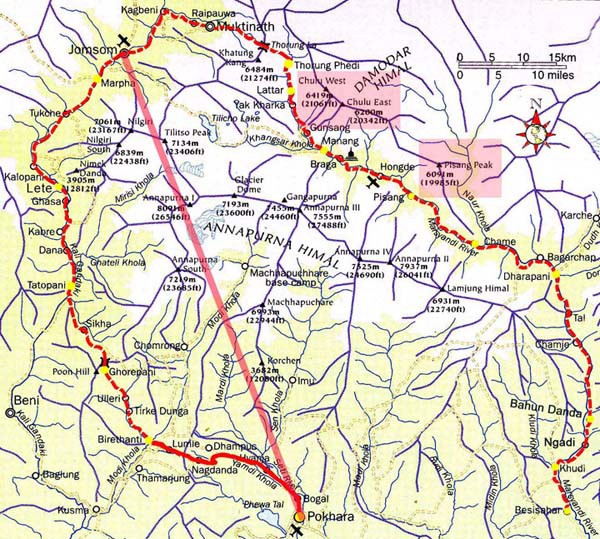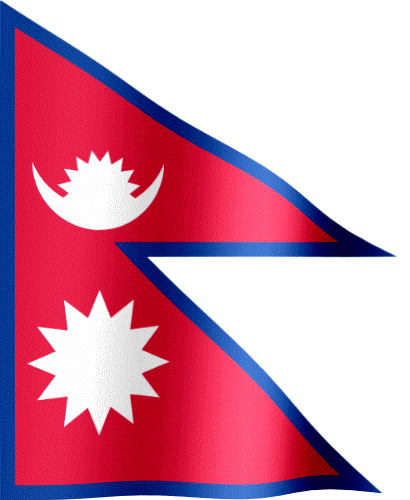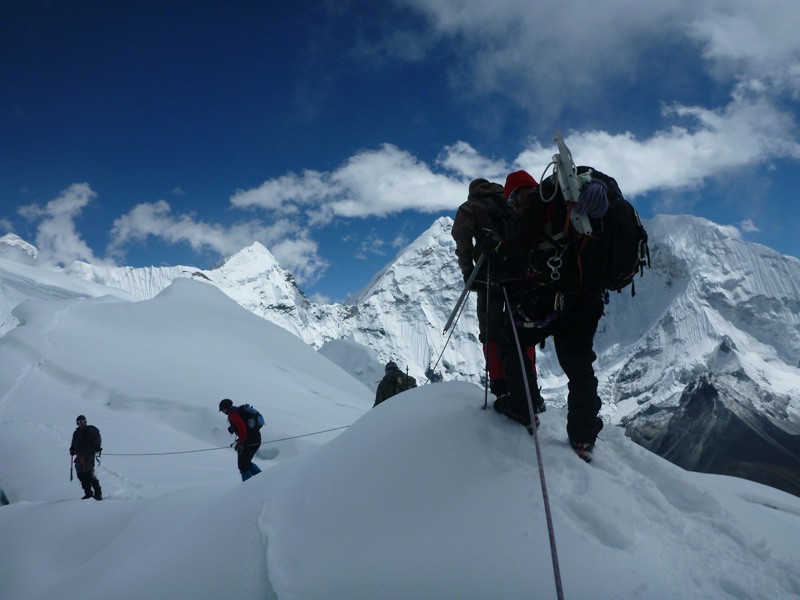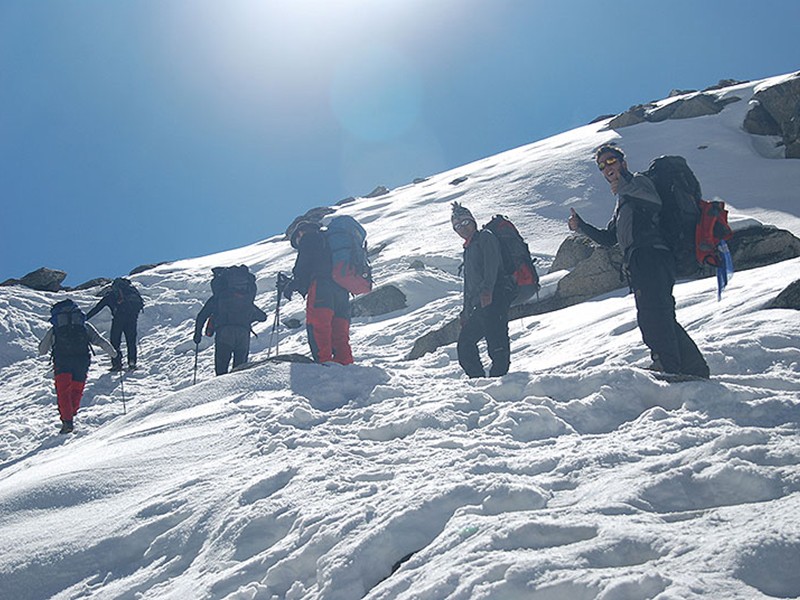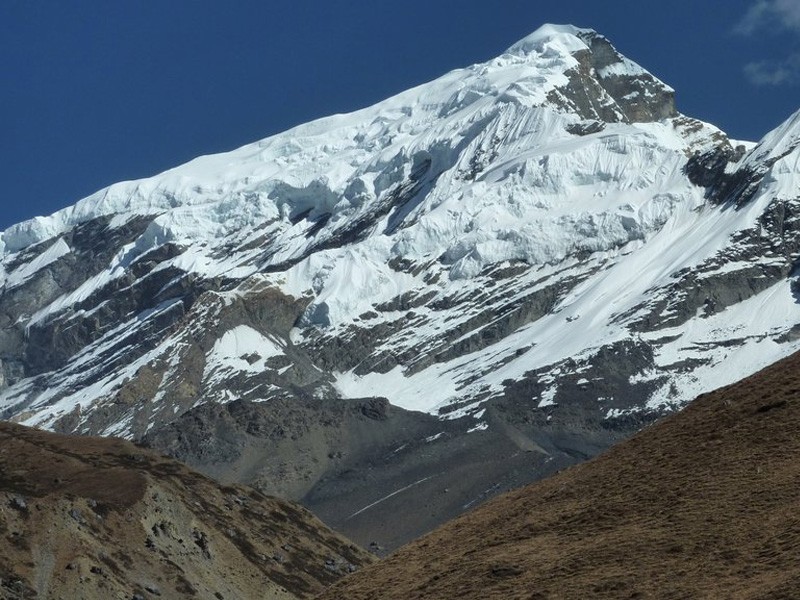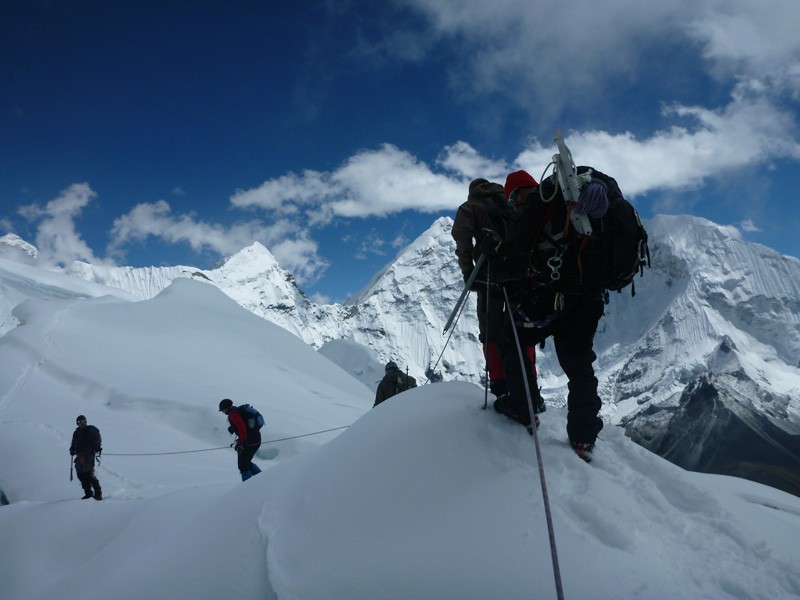Reference Code: MCHWNP
Trip Start: Kathmandu
Trek Start: Besisahar
Trek Days: 16 days
Peak Climbing Period: 4 days
Maximum Altitude: 6427m.
Age: 20-60
Season: Spring and Autumn
Accommodation: Lodge and Camp
Service: Full Board
Destination: Nepal
Trip End: Kathmandu
Trek End: Jomsom
Trip Durations: 21 days
Peak Grade: Extreme
Physical Rating: Strenuous
Group Size: 2-10
Theme: Expedition
Meals: Standard
The highest of these peaks, marked Mt. Chulu West on the trekking maps, has a recorded altitude from at least two expeditions of nearer 6400m; this might more accurately be called Chulu Central. As a result many climbing parties have mistakenly climbed one of these peaks thinking it to be Chulu East or West. It usually understood that with the permit to climb the East or West peak an attempt can be made to the nearby peak as well.
Chulu West peak is part of the Manang Himal, which is quite rightly included in the larger Damodar Himal, the eastern limit of which runs south from Chako and Peak 6687 in a north-to-south direction along the Hunlung Khola, Nar Khola and Phu Khola. To the south it is bounded by the Marsyangdi Khola and the Mesokanta La. There exists considerable confusion with regard to the name and location of the Chulu peaks and what summit actually constitutes Chulu West and Chulu East, since it is soon becomes apparent to anyone that has climbed in the range that several other summits close by, which are actually part of the Chulu massif, are not indicated on present maps of the area. For the sake of clarification, four summits can be included in the Chulu group, two of which are possible on the permit for Chulu West and two on the Chulu East permit. What is apparent is that the available trekking map is highly misleading.
A climb of one or both of these peaks combined with Nepal's most famous Around the Annapurna region make up for one of the most spectacular Himalayan trekking and climbing outings.
Day 01 Arrival in Kathmandu
Namaste! And welcome to Kathmandu, the colourful capital of Nepal where ornately carved balconies mingle with beautiful shrines and temples. Your adventure begins with a welcome meeting on arrival at the exit gate of Kathmandu airport. Our staff will welcome you and pick you to your accommodated hotel. Please seek our company palmplate to find our staff at the main exit gate of the airport. Rest of the day you can relax at the hotel or short evening walk around local market on your own as per your wish.
Approximate Driving Hours: 30 minutes
Accommodation: Hotel
Meals include: None
Day 02 Rest, NMA peak permit issue and preparation day
A well deserved rest day at cosy of hotel after a long tiring flight. This day, one can move around nearby local market to purchase or hire trekking equipment that is necessary for the trekking like sleeping bags, walking sticks etc, exchange currency as requirement or simply walk around in the local market or Kathmandu Durbar squire nearby with small entrance fee as per your preference on your own. In this day our staff will issue NMA Peak climbing permit. Evening at the hotel lobby there will be pre-trip briefing in which you will be introduced with your trekking guide and explained about your trip in short, instruction for safety etc.
Accommodation: Hotel
Meals include: Breakfast
Day 03 Drive to Besisahar 830m. and to Jagat
This morning, drive to Besisahar (approximately 5.5 hours) to immediately immerse yourself in the spectacular mountain wilderness that encompasses the Annapurna Range. After reaching Besisahar, we will have quick lunch. At this place we have to submit our trekking permit to enter inside Annapurna Conservation Area Project site. After permit clarance we will change vehicle and drive with 4WD to Jagat which will take 3 and half hours more. The road is quite bumpy and rough. After reaching Jagat, we will check into a lodge.
Driving Hour: 9 Hours
Altitude gain/loss:
Accommodation: Lodge
Meals include: Breakfast,, Lunch and Dinner
Day 04 Drive to Dharapani 2100m.
Today’s trek continues through the deep wooded canyon embellished by stunning waterfalls. You’ll be venturing into the Manang district of the mountain range, with much of the trail ascending throughout the day.
Walking Hours: 7 hours
Altitude gain/loss:
Accommodation: Lodge
Meals include: Breakfast,, Lunch and Dinner
Day 05 Trek to Chame 2710m.
Marking the end of the great Marsyangdi Gorge, make a steep climb to Timang, then the trail settles into gentler slopes as the vegetation transforms from dense pine forests to drier slopes. The district headquarters of Manang, Chame, is the largest settlement after Besisahar.
Walking Hours:
Altitude gain/loss:
Accommodation: Lodge
Meals include: Breakfast,, Lunch and Dinner
Day 06 Trek to Pisang 3300m.
A slew of breathtaking scenery is on the cards today as the trail goes through a deep gorge, then past the great sweeping slope of Paungi Danda. Today is mostly an easy walk with few ascending stretches of trail dotted throughout the day.
Walking Hours: 5 hours
Altitude gain/loss:
Accommodation: Lodge
Meals include: Breakfast,, Lunch and Dinner
Day 07 Trek to Manang 3540m.
Trek the northern trail via upper Pisang and Ghyaru – an area renowned for its spectacular views. It is now drier and you are sure to come across local farmers herding yaks. Here’s a hot tip – Tibetan yaks take a special interest in people wearing red, so choose your gear carefully today!
Walking Hours: 6 hours
Altitude gain/loss:
Accommodation: Lodge
Meals include: Breakfast,, Lunch and Dinner
Day 08 Rest for AMS
Spend a day here to acclimatise by doing some high climbing, then return to the lower altitude of Manang for the night. Manang, a village of about 500 flat-roofed houses, offers excellent views of Annapurna II, Annapurna III, Gangapurna and Chulu East.
Walking Hours: Depends on wish
Altitude gain/loss:
Accommodation: Lodge
Meals include: Breakfast,, Lunch and Dinner
Day 09 Trek to Yak Kharka 4018
Covering approximately 7 kilometres, today will be a steadily uphill climb into the alpine region of the mountain range. You’ll arrive at Yak Kharka, ready for an easier day of trekking tomorrow to acclimatise to the high altitude.
Walking Hours: 5 hours
Altitude gain/loss:
Accommodation: Lodge
Meals include: Breakfast,, Lunch and Dinner
Day 10 Trek to Chulu West Base Camp
Today, we will trek to the base camp of Chulu West Peak. It will take several hours and we will spend the night in a camp.
Walking Hours:
Altitude gain/loss:
Accommodation: Camp
Meals include: Breakfast,, Lunch and Dinner
Day 11 Rest, basic climbing training and preparation day
This day most of the time we rest at our camp. Afternoon, the climbing support sherpa will brief the team about peak climbing skill and safety on the mountain. After that we will check all our group and personal climbing equipment.
Accommodation: Camp
Meals include: Breakfast,, Lunch and Dinner
Day 12 Climb to High Camp
Today we will trek towards high camp. It is relatively tough but very gratifying. After trekking for around 6 hours we will reach our destination where we will adapt to the harsh environment.
Walking Hours: 6 hours
Altitude gain/loss:
Accommodation: Camp
Meals include: High Altitude food
Day 13 Summit Mt. Chulu West and decent to Base Camp
From the high camp, we will climb the peak from the west side. The climbing will be difficult but worth. After ascending up the main trail, we will finally reach the summit and then slowly climb down and return to base camp.
Walking Hours: 8-9 hours
Altitude gain/loss:
Accommodation: Camp
Meals include: High Altitude food/ Dinner
Day 14 Reserve day for incase
If any problem encounter on the summit day, we will use this day for summit.
Accommodation: Camp
Meals include: High altitude food/ Breakfast, Lunch and Dinner
Day 15 Clean Base Camp and trek to Thorung La Phedi 4450m.
From base camp, we will now trek to Thorong La Phedi, and from here we can have beautiful view of the mountains. After trekking for around 4 hours, we will reach Thorong La Phedi where we will spend the night in a local lodge.
Walking Hours: 8-9 hours
Altitude gain/loss:
Accommodation: Lodge
Meals include: Breakfast, Lunch and Dinner
Day 16 Trek to Muktinath 3800m. by crossing Thorung La 5416m.
Setting off very early to cross the Thorung La Pass (5416 m), the trail is steep but easy to follow. After between 4 to 6 hours climbing, reach the Pass's peak, adorned with prayer flags, a traditional stupa (chorten) and stone cairns built by travellers. Stop to admire the stunning views and marvel at how far you've climbed. Further along, the trail descends steeply proceeding towards Chabarbu. From here on, the trail crosses meadows, drops into a deep ravine, climbs out and follows a wide trail into Muktinath – a pilgrimage site held in great reverence by both Hindu and Buddhist populations.
Walking Hours: 5 hours
Altitude gain/loss:
Accommodation: Lodge
Meals include: Breakfast, Lunch and Dinner
Day 17 Trek to Jomsom
Veer off the main trekking trail to make a side trip to an ancient village of Purang. Further up from the village, continue to take the less frequented route going past another village with a medieval feel to it – Jhong. From Jhong, descend to the Jhing Khola (river), following the course which you emerge on to Kagbeni. From Kagbeni we will hop on a public bus back to Jomsom. This is the last day of our expedition and we will celebrate the success with Nepalese staffs altogether.
Walking Hours: 5 hours
Altitude gain/loss:
Accommodation: Lodge
Meals include: Breakfast, Lunch and Dinner
Day 18 Fly to Pokhara 820m.
Take an early morning flight to Pokhara (approximately 20 minutes). Pokhara is a peaceful lakeside location which rests beneath the snow-capped peaks of the Annapurna Range. Pokhara is part of a once vibrant trade route extending between India and Tibet. This is the land of Magars and Gurungs, hardworking farmers and valorous warriors who have earned worldwide fame as Gurkha soldiers. The Thakalis, another important ethnic group here, are known for their entrepreneurship. Take time to wander around the town and get to know its friendly residents. You might like to sip on a cold brew and gaze up at the dramatic pass that you have just conquered. There are plenty of lakeside cafes where you can enjoy international cuisine, while the main street is full of shops and stalls selling a wide range of Nepali and Tibetan souvenirs. Your simple hotel in Pokhara is set 100 m back from Phewa Lake and with a back-drop of Machhapuchhare rising beyond. It has twin-bedded rooms with attached bath and hot shower facilities.
Flight Hours: 20 minutes Driving hour: 40 Minutes
Altitude gain/loss:
Accommodation: Hotel
Meals include: Breakfast
Day 19 Rest and final shopping day
Enjoy a free day in Pokhara to unwind, relax, and give those muscles a rest after all that trekking. Your leader can advise you of sightseeing opportunities. It is worth taking a boat for a row out on the lake, especially if the weather's fine. The lakeside area has great shopping and cafes. Pokhara has an interesting old area as well as an elaborate Hindu temple and a Buddhist monastery. Perhaps visit the Peace Pagoda, where spectacular views of the mountains await. You can see the Annapurnas from here, and the famous fishtail peak, Machhapuchhare, and back across to Pokhara. You can also visit the fascinating International Mountain Museum to learn some amazing tales of past climbing expeditions.
Accommodation: Hotel
Meals include: Breakfast
Day 20 Drive to Kathmandu 1350m.
Around 9 am we drive to Kathmandu through Prithvi Highway and Tribhuwan Highway with the bank of Marsyangdi river first, then to Daraudi River and Trishuli River. The lenght of the road is 201 km.
Driving Hours 5 hours
Altitude gain/loss:
Accommodation: Hotel
Meals include: Breakfast and Lunch
Day 21 Final departure
We say 'Namaste' for memories that will last a lifetime. There are no activities planned for today and you are able to depart the hotel at any time. Check out time from the hotel is at 12 noon. If you are departing later, you can arrange luggage storage at the hotel. For your final departure, our staff will pick you up from the hotel and transfer to Kathmandu airport approximately 3 hours prior to your international flight time.
Driving hours: 40 minutes
Meals include: Breakfast
Inclusion
All ground transportation as per itinerary
3 night hotel accommodation in Kathmandu with B/B plan.
2 night hotel accommodation in Pokhara with B/B plan.
TIMs (Trekking Information Management system) card
Annapurna Conservation Area Entry fee
Peak climbing permit
Food for the members on Lodge/Camping basis
Lodge charges
All camping equipment and camping charges during climbing period
All required group climbing equipments( like fixed ropes, man rope, ice bar, ice screw.....)
All required Nepalese staffs including climbing support sherpa
Climbing support Sherpa equipments
All Nepalese staffs insurance
Company service charge and government taxes etc.
Exclusion
International flight with airport tax.
Nepalese Entry Visa fee
Food during stay in Kathmandu and Pokhara
All personal equipment and personal expenses
All personal climbing gears
Photography Charges, Monument charges and Monument entry fees
Personal Medical and travel insurance(must cover helicopter rescue evacuation cost)
Personal Medicine
Telephone and internet charges
Laundry charges
Alcoholic beverage, bottled drinks and cold drinks during the trip
Rescue evacuation charges if required
Staff and porters Tips...
Equipment List
This trekking equipment list has been prepared by Adventure Zambuling Treks (P) Ltd.
Climbing equipment:
» Climbing harness;
» One 3 metre/10 foot sling and three 2 metre/6 foot slings.
» Figure 8/Abseil belay device;
» 1 large mitten sized ascender (most members use the large petzl) and arm length leash;
» 2 locking carabiners, (1 large and 1 small)
» 4 regular carabiners;
» Good quality Ice axe with leash;
» Crampons - must fit boots perfectly. Steel crampons with anti-balling (anti-bot) plates are the best;
» Optional; Adjustable trekking poles;
Upper Body:
» 2 cotton t-shirts;
» 1 polypropylene t-shirt;
» 1 long sleeve polypropylene shirts, lightweight;
» 1 polar fleece pullovers, medium weight;
» 1 polar fleece jacket.
» Gore-Tex jacket with hood, waterproof and breathable;
» Lightweight down jacket for those chilly days in camp;
Hands:
» 1 pr. lightweight poly-liner gloves. These will be worn when tying knots, but not inside your mitts;
» 1 pair mittens, consists of 1 Gore-tex over mitt matched with the very warm polar fleece mitt liner (For more about high altitude mitts.
Head:
» Warm hat wool or synthetic that covers your ears;
» Balaclava;
» Face mask;
» Ballcap or brimmed suncap;
» Glacier sunglasses with side shields (you can purchase these inexpensively in Kathmandu,
» 1 pair ski goggles (Optional) with light and dark lens;
» Headlamp with extra batteries and bulbs;
» Bandana or head scarf, also useful for dusty conditions.
Lower Body:
» Cotton underwear briefs;
» 1 pair walking shorts;
» 1 pair walking trousers for trekking and around camp;
» 1 pair lightweight thermal bottoms;
» 1 pair medium or expedition weight thermal bottoms;
» 1 pair polar fleece trousers;
» 1 pair Gore-Tex trousers, salopettes, or bibs. Waterproof/breathable with full side zips;
Your clothing should be kept dry using waterproof stuff sacks, bin-liners, or large plastic bags.
Feet:
» 1 pair Double Plastic boots (Koflach);
Modern single waterproof-leather climbing boots with special insulation for cold weather/winter climbing on 4000 metre/13,000 foot high peaks are OK, as long as they will fit comfortably with two thick pair of socks and a vapour barrier liner and the boot will fit the crampon perfectly.
» 1 pair sturdy leather walking boots with good ankle support (we mean leather trekking, not climbing boots) for the trek;
» 1 pair trainers, running shoes and/or sandals for Kathmandu and in camp;
» 1 pair down booties (optional);
» 2 pair med-heavy poly or wool socks;
» 2- pair of liner socks. Polypropylene or wool;
» Vapour barrier liner socks or plastic bread-bags;
» 2 pair lightweight trekking socks, poly or wool;
» Cotton socks for in town.
Sleeping:
» 1 good quality sleeping bag (good to -30 degrees C)
» At least 1 closed cell foam kari-mats. We do not recommend inflatable mats, as we have never seen one not puncture. You can buy these non inflatable mats very inexpensively in Kathmandu. Why carry foam mats around the world, when you can purchase them inexpensively in Kathmandu?
Your sleeping bags should be kept dry using waterproof stuff sacks, bin-liners, or large plastic bags.
Rucksack and Travel Bags:
» 1 medium rucksack (50-70 litres / 3000-4500 cubic inches, can be used for airplane carry);
» 1 or 2 large (120 L / 7500 cubic inch) duffle kit bags for clothing and equipment. Must be durable for use on pack animals or porters;
» Small padlocks for duffel kit bags.
Personal Hygiene:
» female or male hygiene supplies;
» 2 tubes lip sun cream, 1 large tube skin sun cream (min.factor 15);
» anti-mosquito cream;
» 1 toothpaste/brush;
» 1 bar soap or hand sanitizer gel/1 small towel;
» hand wipes.
Medical:
Medications are inexpensive and readily available in Kathmandu with no Doctor`s prescription:
» small personal first-aid kit. (Simple and Light) Aspirin, first-aid tape, plasters (band-aids), personal medications, etc. The leaders will have extensive first-aid kits, so leave anything extra behind. Please let your leader know about any medical issues before the climb;
» 1 skin blister repair kit;
» 1 small bottle anti-diarrhea pills;
» 1 small bottle anti-headache pills;
» 1 small bottle cough and/or cold medicine;
» 1 small bottle stomach antibiotic: Ciprofloxacin, etc.;
» 1 small bottle anti-altitude sickness pills: Diamox, Acetylzolamide.
» Do not bring sleeping pills. They are a respiratory depressant;
» 1 small bottle of water purification tablets or water filter;
» 1 set earplugs;
» Extra prescription glasses, contact lens supplies. Contact lens wearers, please bring glasses in case of emergency. A new pair could be quickly made in Kathmandu, Lhasa, or Kashgar for just $20. Please order upon arrival if you are interested.
Personal Food:
On the mountain we supply plenty of food for you to cook 3 hot meals each day. This food will consist of soup, local cheese & sausage, biscuits, dried noodles, potatoes, rice, porridge, butter, dried and tinned vegetables, fruit, meats, and fish, tea with milk and sugar, powdered juice drink, and drinking chocolate. Our sherpas/local porter will be carrying this food to the higher camps.
» We ask each member to bring their own imported daily snack and energy foods. We do not provide cold “snack” food such as chocolate or "energy-bars". We ask that you bring or buy your own "snack" or daily cold energy food, 2-3 kilos/4-6 pounds is a good amount (for the trek and Island Peak combined). A growing variety of imported foods such as European and American cheeses, chocolates, biscuits, cookies, nuts, and locally made power-bars are now available in Kathmandu, at realistic prices. However, imported power bars, GU, re-hydration drinks, dehydrated food, "freeze-dried meals", imported cheese and sausage are not available. If you want these items, you must bring them from your home country. Many of our members, especially Britons, Europeans, and Australians with tiny baggage allowances, now purchase their daily snacks in Kathmandu. Our schedule in Kathmandu allows plenty of time for shopping.
Practical:
» 1 small roll of repair tape, 1 sewing repair kit;
» 1 cigarette lighter, 1 small box matches;
» 1 compass or GPS;
» Recent good quality map of visiting area.
» 1 battery powered alarm clock/watch;
» 1 camera and film, or digital camera with extra cards and extra batteries;
» nylon stuff sacks For food and gear storage, large Ziplocs are useful also;
» 3 Water bottles (1 litre) wide-mouth Nalgene (1 is a pee bottle);
» 1 plastic cup and spoon;
» 1 small folding knife;
» binoculars (optional);
» 4 large, waterproof, disposable rubbish sacks;
» passport, 2 extra passport photos, flight ticket, flight itinerary;
» separate photocopies of passport and relevant visa pages, proof of insurance;
» dollars, pounds or euros cash for purchasing Nepalese visa at Kathmandu airport, Tibet visa, for paying for restaurants and hotels, for gratuities, snacks, and to purchase your own drinks and gifts;
» credit cards, Bank/ATM/Cash machine cards for use for withdrawing funds from cash machines (bring a photocopy of your cards), traveler's checks, etc.;
» 1 bathing suit/swimming costume (you never know);
» basecamp entertainment. It is good to bring additional items which you have found to be useful on previous expeditions. For example: paperback books, playing cards, ipod mp3 player, short-wave radio, game boys, musical instruments, ear plugs, lots of batteries, etc.;
» travel clothes for basecamp and in town;
This Peak Climbing equipment list has been prepared by Adventure Zambuling Treks (P) Ltd.
Please submit any equipment questions or concerns to: info@advzambuling.com
